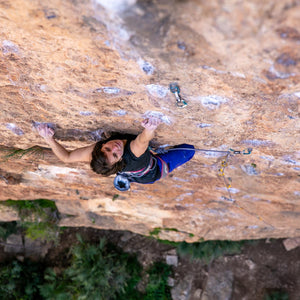Get a grip: is your climbing chalk bad for the planet?
Spot the holds. Chalked holds can be spotted from hundreds of meters away as a result of years of climbing.
Alice Hafer, Chulilla, Spain.
*Ba-da-boom-ba-da-boom-ba-da-boom*…Your heart’s racing, your forearms are burning, your focus zooms into the next hold. It’s you against the growing tug of gravity. You reach into your chalk bag.
*Pat pat pat* Suddenly confidence flows through your body as you nail the crux.
It’s rare to head to a climbing wall or crag without seeing most hands powdered up with chalk. But, what exactly does it do? Do you really need it? Where does it come from? We’re here to give you the lowdown on chalk and share some tips on how to be a sustainable chalk-using climber.
When you’re climbing or bouldering, it’s natural for your hands to get sweaty. And that’s why we use chalk. It absorbs the sweat, making your hands drier. With dry hands you can get more friction between your hands and the holds or the rock, and this means the holds feel much more welcoming (and less like the route is trying to spit you off).
Dry hands = better friction and better grip on the rock or climbing holds.
(And once you get into the habit of chalking up when climbing, it does seem to give a psychological boost too. 💪)
But where did this ritual come from?
To paraphrase Salt-N-Pepa,
Let’s talk about chalk, baby..
let’s talk about all the good things,
And the bad things that may be…
Go easy on the chalk - too much and you’ll be slipping off the wall like a penguin on ice
Photo by: Matthew Hume
A very short history of climbing chalk 🤓
We’ve got gymnast John Gill to thank for the introduction of chalk into the climbing world. Coming from the world of gymnastics where chalk use was already commonly used, in 1954 he started using it when climbing and bouldering.
The use of chalk spread as climbers realised that with a dab of the white stuff they could climb harder routes. Love it or hate it, the use of chalk has become pretty universal, with climbers of all levels routinely chalking up before reaching for that first hand hold.
Now things are edging in the opposite direction with chalk use being restricted in some climbing areas (both indoor gyms and on outdoor crags). The use of chalk on outdoor rock in particular is being questioned, and rightly so. It’s not always necessary, and having all the holds marked in white does take some of the problem-solving of climbing out of the equation. Can you really call it on-sight if all the holds are marked in white?
It’s probably time we all started being a bit more mindful about how and when we chalk up.
And we also need to think about where our climbing chalk comes from and the environmental impact it has.
What is climbing chalk made of?
Chalk is essentially magnesium carbonate (MgCO₃ if you want to impress!). But not all chalk is equal. It often contains impurities and fillers, and may contain toxic heavy metals like lead, arsenic and chromium. This is partly due to how the majority of chalk is sourced.
China is the home of the lion’s share of the world’s open pit chalk mines - where most climbing chalk comes from. The process is energy intensive (and most of this energy comes from petrol) and not only pollutes the local area but also leaves huge eyesores in the landscape.
What’s more, in some climbing chalk you’ll find other fillers and additives. If you have naturally dry skin, any drying additives in your chalk will only make things worse. In our experience, we’ve found that higher grade pure chalk is the best chalk for climbing, and with better quality chalk (without fillers and additives) you don’t need to use as much so a little goes a long way.
There is an alternative to mined chalk (that potentially contains heavy metals) – keep on reading to see what makes our Techno Chalk a sustainable choice.
As outdoor-lovers we need to make sure we protect and preserve the natural environments we love so much… Photo by: Guy Mor
Is climbing chalk bad for the environment?
As outdoor-lovers we need to make sure we protect and preserve the natural environments we love so much. And that includes the rock we climb on. And where does climbing chalk come into the equation? As well as looking at how it’s sourced, we also need to consider the impact it has when we use it.
A study has shown that climbing chalk actually has a negative impact on rock dwelling species (ferns and mosses). Even when there are no visible signs of chalk (so even when you clean it off), chalk use changes the pH and nutrient conditions of the rock, having a negative effect on the survival and germination of ferns and mosses.
This is in addition to the growing controversy around excessive chalk-use in popular rock climbing areas, as routes with a patchwork of white marks don’t look great and it takes away some of the challenge of working out a route when all the holds are glaringly-obvious thanks to white marks across the rock.
At 3RD ROCK, we love how climbing has become more and more popular. But this increased popularity has consequences. More climbers inevitably mean more chalk marks, especially in popular climbing areas and on bucket-list-worthy routes. So, what can we do to make things better?
Here are our tips for chalking up outdoors:
-
Use less - try not using chalk at all, especially on easier grade climbs. You might be surprised to find that you can climb just as well without. To get out of the nervous-twitch habit of chalking up every time the going gets tough, try leaving your chalk bag on the ground next time you climb. And anyway, too much chalk on your hands actually has the opposite effect of reducing your grip. So, go easy tiger!
-
Take less (or leave your chalk on the ground) - Don’t fill your chalk bucket to the brim - this also means there’s less chance of spillage or wastage). If you don’t have as much chalk to hand, you’re more likely to use it sparingly.
-
Buy better - buy good quality chalk that sticks to your hands well and doesn’t disappear 2 moves after chalking up. And buy sustainably-sourced chalk. Who wants to use chalk that is produced in a way that massively pollutes the planet?
Maybe you’re thinking, “If you want to be really environmentally-friendly, stop using chalk at all.” Yes, you’re absolutely right. But we also recognise that compromise is the key. Maybe one day the use of climbing chalk will be only found in the history books. But for now, we wanted to give you, our climbing community, the most sustainable option we could find.
It's possible to make chalk in a more sustainable way.
In the photo: 3RD ROCK Techno Chalk
Say hello to eco friendly climbing chalk
Our Techno Chalk is sourced sustainably - magnesium carbonate is extracted from seawater as a byproduct of desalination. This process is way more environmentally-friendly compared to mining chalk, and although it’s not perfect – it still uses energy for example – unlike mining, the energy used can come from renewable sources. What’s also really great is that the chalk is a higher grade of purity. This means a little goes a long way, so you won’t need to chalk up as frequently.
Better quality AND more environmentally friendly? You bet. 💪
Techno Chalk comes in a generous-sized plastic-free tube and it’s a chunky blend of chalk. It’s easy to transfer to your bucket or bag without making a colossal mess and the chunks break down easily into a fine powder for you to use.
This reviewer summed it up better than we ever could:
"High quality chalk that doesn't cost the earth!
The Techno Chalk has been awesome. First off, I love that it is sustainably sourced as a byproduct and arrives in a recyclable tube. Climbing wise, this chalk sticks to my hands really well, and doesn't sweat or wear off too quickly. The chunky texture also feels great, and is less wasteful than powder. Definitely recommend!"
Written by Jane Nizi
Sep 21, 2023



